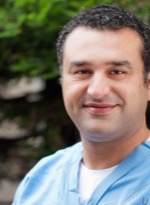- The Vascular Surgeon Just Booked an Emergent Acute Aortic Syndrome: What Do I Need to Know as the On-Call Anesthesiologist?
- 9:15-10:15 a.m. Wednesday
- West, Room 2006
As endovascular aortic surgeries continue to treat more complex and acute pathologies, anesthesiologists must evolve along with them. This morning’s session “The Vascular Surgeon Just Booked an Emergent Acute Aortic Syndrome: What Do I Need to Know as the On-Call Anesthesiologist?” addresses the types of general and acute cardiovascular aortic emergencies on-call anesthesiologists are likely to encounter, with the goal of optimizing the perioperative management of these cardiac patients to improve outcomes.
“In aortic emergencies, patients usually present with major hemodynamic instability that needs to be addressed immediately. Anesthesiologists must also be prepared to quickly decide, for example, if rapid ventricular pacing will be needed or whether subclavian or femoral access is necessary. To improve perioperative safety, we must be familiar with the various clinical presentations of these syndromes and coordinate our anesthesia management with the vascular surgeon’s case management,” said Ahmed Shalabi, M.D., Chief of Vascular Anesthesia at the University of California, San Francisco.

Ahmed Shalabi, M.D., prepares on-call anesthesiologists for cardiovascular aortic emergencies and the role of perioperative management.
Dr. Shalabi leads the session with a discussion of the main concepts of modern aortic repairs, including the anatomy of different aortic pathologies that lead to acute aortic syndromes.
Over the past two decades, managing acute aortic emergencies has changed dramatically, transitioning from open surgery, which had a high rate of morbidity and mortality, to more innovative and less invasive endovascular techniques.
“Today, endovascular surgery is taking more of the upper hand,” Dr. Shalabi said. Attendees will become familiar with the latest, cutting-edge surgical procedures and endovascular treatment options, including branched and fenestrated thoracoabdominal grafts, snorkel stent devices and hybrid arch repairs.
Kirsten R. Steffner, M.D., Clinical Assistant Professor of Anesthesiology, Perioperative and Pain Medicine at Stanford University School of Medicine, will discuss the anesthesia management of aortic endoleaks, a complication that can develop after endovascular aneurysm repair (EVAR). EVAR has emerged as a viable alternative to open repair for abdominal aortic aneurysms. Dr. Steffner also will familiarize attendees with endovascular arch repairs and differentiate the types of cases that would require cardiac anesthesia.
Michael P. Bokoch, M.D., Ph.D., Assistant Professor of Anesthesia and Perioperative Services at the University of California, San Francisco, will round out the panel with a discussion of the risks and management of acute kidney injury, mesenteric ischemia and CNS ischemia during thoracic aortic surgery.
“It’s important to be able to identify the different acute aortic syndrome pathologies and have an understanding of the treatments and new devices vascular surgeons are deploying to manage patients during the perioperative period,” Dr. Shalabi said.
The session will provide case studies to help attendees interpret these complex and acute cases and optimize the anesthetic management.
Return to Archive Index